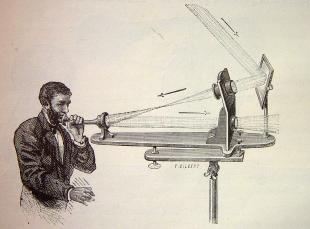When you pack a survival kit for disaster and emergency situations, what kind of tools would you include? I bet flashlight is one of them. Besides its obvious use, a flashlight can be toggled on and off to send Morse coded signals for requesting help and rescue. It is thus a good idea to always remember the Morse code for SOS: [•••−−−••• ]. This is a simple example of optical wireless communication: a technology that has been around for a long time over a wide range of applications with very simple to very sophisticated designs.
Optical wireless communication refers to the transmission of data using light propagating through the air (or free space) without being guided by any waveguide structure such as optical fibre. The use of smoke signalling in ancient China, optical telegraphy (Heliography) based on mirror-based sunlight reflections in 19th and early 20th century, and the invention of the photophone are some of the early examples of optical wireless communication. The photophone, invented by Alexander Graham Bell in 1880 (U.S. Patent 235,199), is indeed the most sophisticated design among these primitive optical wireless systems. It could transmit human conversation carried by a beam of light (sunlight) over an atmospheric link with a distance of few hundred meters. Despite the significant interests in the invention of telephone, Bell believed that the photophone was "the greatest invention [he has] ever made, greater than the telephone"; as he told a reporter shortly before his death.
The invention of the Photophone
Today's Optical wireless technology is equipped with sophisticated coding and signal processing techniques to provide a secure, license-free, and high-capacity alternative to RF (radio frequency) wireless communication and a cost-effective and easy-to-install alternative to fibre optics. The technology is usually known as visible light communication (VLC) or LiFi in indoor applications and free-space optical (FSO) communication in outdoor terrestrial or space applications. Although some of the applications are still emerging, the technology has been implemented in various forms in recent years. For example, during 2010 FIFA world cup in South Africa, BBC used an outdoor optical wireless link for high-speed transmission of HD video streams.
Optical wireless communication can play a major role in the future 5G multi-technology networks providing a wide range of services such as mobile backhaul, indoor ultra-high-speed data access, satellite/airborne communication, indoor positioning system, vehicle-to-vehicle communication, and temporary (e.g., events, disaster recovery, etc.) networks. It is also crucial in the development of some emerging technologies such as the unconditionally secure communication through quantum cryptography.
By Majid Safari


